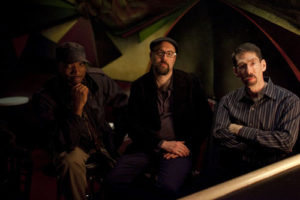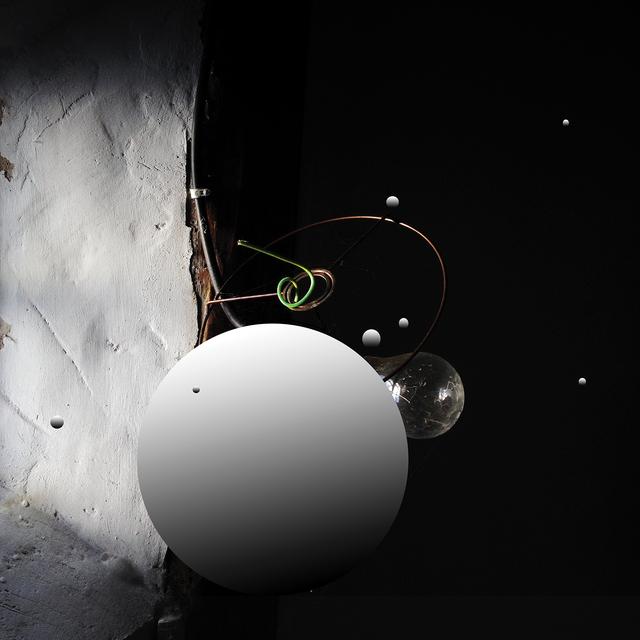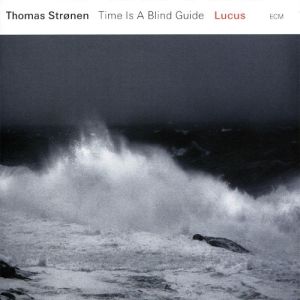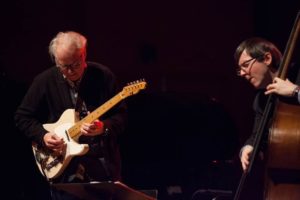
- Christian Carey (christianbcarey.com)
The Original New Music Community

Anna Webber
Clockwise
Pi Recordings (2019)
Saxophonist/flutist/composerAnna Webber, a thirty-five-year-old who has already won a Guggenheim Fellowship and numerous other plaudits, makes her Pi Recordings debut with Clockwise.Joined by an estimable group of avant-jazz musicians – pianist Matt Mitchell, Jeremy Viner playing tenor saxophone and clarinet, trombonist Jacob Garchik, cellist Christopher Hoffman, bassist Chris Tordini, and percussionist Ches Smith-Webber plays tenor saxophone and flute on the CD. Her compositions are mostly extrapolations of pieces for percussion by twentieth century classical composers Morton Feldman(King of Denmark), Iannis Xenakis(Persephassa), Edgard Varése(Ionisation), Karlheinz Stockhausen(Zyklus), Milton Babbitt(Homily), and John Cage (Third Construction). Employing percussion music to organize musical structures yields fascinating and fertile hybridized compositions.
Array, based on Babbitt’s Homily, a solo piece for snare drum, uses the score’s serialized dynamics and attack points to craft a welter of overlapping arpeggiations inhabited by the entire group. King of Denmark is visited in three different incarnations on Clockwise, the first lifting off with a bracing hail of noise-inspired multiphonics before moving into an undulating groove that positions the rhythm section front and center. The second features an introduction in which Smith plays glissandos on timpani alongside chiming interjections. This is succeeded by a sultry main section, pitting walking lines from Tordini against microtonal winds. King of Denmark III is the briefest trope on Feldman, juxtaposing a roiling arco solo from Tordini against saxophones overblown.
The title track takes the modularity of Stockhausen’s original as a cue for its own set of disparate, time-linked sections. Cage’s Third Constructionis channeled on Hologram Best, which features angular saxophone and brass lines in ebulliently spinning motion. Idiom II is the sole track on the disc to be composed with Webber’s own material. Near unison saxes, just slightly out of sync, create a loping tune that is punctuated by thrumming percussion and bass notes. Gradually, the rhythm section exerts a more intrusive presence that rivals the saxophone ostinato. Ultimately, the head is banished in favor of a saxophone-piano duet, in which Mitchell plays from an attractive palette of complex harmonies. Inexorably, the saxophones push back. Now no longer in near-unison, deployed in counterpoint, they take a break of their own that is only gradually infiltrated by the rhythm section. The final section of the piece features ostinatos again, this time with blocks of reeds, harmonizing the original tune, taking the front line in the proceedings while the rhythm sections positively roars its propulsive support. A brief reappearance of the head ensues, and then the door slams shut on the most compelling music of the recording.
Varése and Xenakis inspire the works Kore I and Kore II. The latter opens the disc with undulating pizzicato strings that are eventually joined successively by flute, piano, and the rest of the ensemble in an off-kilter, post-tonal dance. Kore I closes the recording with another pileup of material, starting from pianissimo feints from the rhythm section and eventually building to a portentous moto perpetuo in which solos from Tordini, Webber, and Garchik are finally subsumed into a furious tutti coda.
Whether Webber is exploring avant-garde classical masters or paving her own pathways, she proves to be a compelling creator. Her collaborators, to a person, are stellar. Clockwise is heartily recommended.

Photo: John Rogers.
Fred Hersch Trio
Village Vanguard
January 5, 2019
Sequenza 21
By Christian Carey
NEW YORK – Beginning the new year with a six-night long residency at the Village Vanguard, pianist Fred Hersch had a lot to celebrate. His current trio, in which he is joined by bassist John Hebert and drummer Kevin McPherson, has been together for a decade. They have received a Grammy nomination for their 2018 Palmetto Records CD Live in Europe. In December, Palmetto released another recording of Hersch in a trio setting, this one from 1997 with bassist Drew Gress and drummer Tom Rainey. 97 @ The Village Vanguard is the only live recording of this acclaimed ensemble. The CD also documents Hersch’s debut as a leader at the Village Vanguard.
Many celebrations include guests and Hersch’s residency was no exception. For the last three nights of shows, alto saxophonist Miguel Zenón, a Grammy nominee himself and a Guggenheim Fellow and MacArthur Award winner to boot, joined the trio. It proved to be a felicitous pairing. After the trio opened the set with Hersch’s meditative “Plainsong,” Zenón joined them on the pianist’s salsa original “Havana,” sending its sinuous melody soaring and building an exquisitely paced solo. Hebert and McPherson created a fulsome groove. McPherson’s ability to move from the pianissimo textural playing of “Plainsong” to the driving polyrhythms of “Havana” demonstrated versatility that turns on a dime. Hebert keenly targeted his playing too, moving between registers, engaging in melodic colloquy with Hersch, supporting the changes, and acting in concert with McPherson. All of this is even more noteworthy when one considers his uncanny ability to know exactly when and where to provide Hersch’s playing registral space.
Hersch’s music is often rhythmically intricate. In addition to the facility of the rhythm section, Zenón proved his mettle in the abstract phrasing and polyrhythmic environments of Hersch tunes “Snape Maltings” and “Skipping.” The latter tune elicited a verve-filled solo from Hersch. The pianist and saxophonist also made great foils for each other, one developing melodic breadcrumbs that the other had strewn in a previous solo. Zenón’s playing had a bite in the post-bop material, but was smooth and suave in the Lerner and Loewe’s “I’ve Grown Accustomed to Her Face.” Zenón’s composition “Temes” was an engaging part of the set, and it was fascinating to hear Hersch go to town on material new to him, displaying a vivid imagination.
Hersch frequently writes compositions in homage to other jazz artists. “Lee’s Dream” is a contrafact tune, using the changes of Nacio Herb Brown’s “You Stepped Out of a Dream” with a new melody. It is dedicated to Lee Konitz. “Monk’s Dream” is dedicated to Thelonious Monk. During his set at the Vanguard, Hersch had Monk in mind. The closer was a one-two punch of the pianist’s harmonically inventive version of “Round Midnight,” followed by the group playing a rousing rendition of “Let’s Cool One.” Obliged by applause to share an encore, Hersch chose Billy Joel’s “And So it Goes,” starting in eloquent simplicity and then transforming the tune with intriguing modulations into a Chopin-esque reverie. The sold-out crowd seemed delighted to share in the celebrations.

Tangents
New Bodies
Temporary Residence Ltd.
Australian instrumental quintet Tangents return with their fourth album via Temporary Residence. It is their finest work in some time, with an even broader palette of materials and stylistic reference points that are adroitly incorporated. The combination of cello, especially favoring pizzicato, and synth melodies remains, but along for the ride are prepared piano sounds, angular bass interjections, and skittering beats. Electric guitar textures and and undulating patterning are propelled by muscular acoustic drums.
Indebted to post-rock, jazz, alt-electronica, and a dose of contemporary classical sounds, it transcends these various categorizations and their carbon dating to create music that is entirely fresh and of the moment. Recommended.

Obsidian
Kit Downes, organ and composer; Tom Challenger, tenor saxophone
ECM Records
Prior to this recording, Kit Downes was primarily known as a pianist in jazz settings, notably leading his own trio and quintet. Obsidian is his debut CD as a leader for ECM Records; he previously appeared on the label as part of the Time is a Blind Guide release in 2015. However, Downes has a substantial background as an organist as well. The program on this recording consists primarily of his own works for organ, but there is also a noteworthy folk arrangement and engaging duet with tenor saxophonist Tom Challenger.
The organs employed on Obsidian are all in England, two in Suffolk at the Snape Church of John the Baptist and Bromeswell St Edmund Church, and Union Chapel Church in Islington, London. Instruments from different eras and in very different spaces, they inspire Downes to explore a host of imaginative timbres and approaches. Over an undulating ostinato, skittering solo passages impart a buoyant character to the album opener “Kings.” An evocative arrangement of the folk song “Black is the Colour” pits piccolo piping against ancient sounding harmonies in the flutes and bagpipe-flavored mixtures. “Rings of Saturn” is perhaps the most unorthodox of Downes’s pieces, filled with altissimo sustained notes and rife with airblown glissandos, an effect that is not found in conventional organ repertoire. The piece is well-titled, as it has an otherworldly ambience. Pitch bends populate “The Bone Gambler” as well, while vibrato and frolicsome filigrees animate “Flying Foxes.” “Seeing Things” is a joyous effusion of burbling arpeggios and the more usual fingered glissandos, demonstrating an almost bebop sensibility. Suitably titled, on “The Last Leviathan” Downes brings to bear considerable sonic power – with hints of whale song in some of the textures – and fluent musical grandeur.
Although some of the release seems inimitable, closely linked to Downes’s improvisatory and textural explorations, other pieces cry out for transcription; one could see other organists giving them a wider currency. “Modern Gods” is an exercise in modally tinged dissonant counterpoint, while “Ruth’s Song for the Sea” and the folk-inflected “The Gift” possess the stately quality of preludes.
The duet with Challenger is a tour de force, in which each adroitly anticipates and responds to the other’s gestures and even notes, as the fantastic simultaneities that occur at structural points in the piece attest. Once again, there is a supple jazz influence at work. While Downes provides room for Challenger’s solos, he also challenges him with formidable passages of his own. Obsidian contains much textural subtlety and fleet-footed music, but it is also gratifying to hear Downes and Challenger celebrating the power of their respective instruments. Heartily recommended.

Thomas Strønen – Time is a Blind Guide
Lucus
ECM Records 2576
Ayumi Tanaka, piano; Håkon Aase: violin; Lucy Railton, violoncello; Ole Morten Vågan, double bass; Thomas Strønen: drums, percussion
Composer/percussionist Thomas Strønen’s Time is a Blind Guide has shifted membership since its debut recording. Distilled to a quintet line-up on Lucus, its latest outing for the ECM label, it retains a cohesive way of interacting that highlights a fluent interplay of textures. The Mediterranean-inflected album opener “La Bella,” the sole composition on which Strønen shares credit with Aase and Vågan, is a case in point. Fills from Strønen’s kit activate repeated notes in the strings and piano in a subtle build that gradually includes ever widening whorls of melodic snippets.
Often Strønen wisely deploys the quintet as an interlocking set of two trios – string trio and jazz piano trio. This is done quite effectively on “Wednesday;” the jazz side of the ensemble plays in a smoky swinging groove while Aase and Railton perform a gentle rainstorm of pizzicatos. Vågan is an interloper, moving from walking lines to sultry arco playing. On the title track, also undergirded by a propulsive string ostinato, Tanaka supplies limpid impressionist cascades. The strings build up successive layers, creating countermelodies that arc around the piano and accentuate the undergirding material of the rhythm section. The double trio idea also prevails in the standout composition “Truth Grows Gradually,” in which the players revel in a complex yet catchy groove.
Elsewhere, the ensemble activities vary. On “Baka,” the percussionist crosses over into the world of orchestral instruments, bringing out regular bass drum punctuations. “Friday” juxtaposes pizzicato solos with high string harmonics in a polyrhythmic duet enlivened by its textural contrasts. After an extended double bass introduction, “Tension” presents folk-tinged violin melodies and attenuated post-bop piano lines against a variety of jazz kit punctuations by Strønen. Gradually, Tanaka fills out the texture with rapid fire repeated notes against an expansive collection of string glissandos and harmonic minor pirouettes. The Eastern-tinged “Release” leads with a sweeping piano melody that alternates with oscillating strings and thrumming low register pedals. Oddly enough, “Release” is placed earlier on the disc than “Tension,” which would seem to be a corresponding antecedent. That said, the sequencing of these compositions flows organically with ample variety along the way. Whether performing again as a larger group or in the quintet that appears on Lucus, one hopes that Time is a Blind Guide are just getting started.
-Christian Carey

Photo: Claire Stefani
Bill Frisell and Thomas Morgan
The Jazz Standard
December 10, 2017
Sequenza 21
By Christian Carey
NEW YORK – Like the dearly departed duo of Jim Hall and Charlie Haden, guitarist Bill Frisell and bassist Thomas Morgan make a sound much greater than the sum of their parts. This is not an issue of amplitude – their set on Sunday December tenth at the Jazz Standard was perfectly scaled for this intimate space. However, in terms of richness of rapport, musical detail, and imaginative improvisation, they can stand toe-to-toe with many larger groups. In part, they seem like a bigger ensemble because of the sheer number of notes per bar that their interplay encompasses and the quick shifts that occur between registers on their respective instruments.
There is another touching and musically fulfilling aspect to the pairing. While Frisell is the “veteran,” chronologically speaking, Morgan needn’t and doesn’t adopt a subordinate role: their interplay is on an equal footing. Frisell and Morgan began with “Days of Wine and Roses,” a venerable pop song turned jazz staple by pianist Bill Evans and memorably interpreted by guitarists such as Wes Montgomery and Joe Pass. Here, there was no feeling out process; it was an interweaving dialogue from the get-go. Frisell and Morgan seldom look at one another; such is their sense of each other’s unfolding strategy that they seldom need to do so. They seamlessly “duck” above and below each other, covering several octaves in their musical repartee.

Some of the set took tunes from Small Town (ECM, 2017), Frisell/Morgan’s live recording of a March 2016 stint at the Village Vanguard. A standout that appears on the CD is the fetching ballad by Morgan, “Pearl,” a tune with a turn around that contains just a whiff of “My Only Love” and is adorned with chromatic changes. Frisell supplied an original of his own, “Strange Meeting,” originally recorded back in 1984 on the guitarist’s ECM album The Rambler. While Morgan generally takes a polyphonic and harmonic approach to bass playing, here he imitated the pulsations found on the original recording (courtesy of Jerome Harris and Paul Motian), his instrument thrumming with intensity.
Both Thelonious Monk’s “Misterioso” and “Subconcious Lee” by Lee Konitz gave the two opportunities to switch gears to demonstrate facility in the bebop idiom. Later, the Carter Family’s “Wildwood Flower” presented another avenue of inquiry long in Frisell’s kitbag: the refraction of Americana and folk music through a jazz lense.
In a year fraught with violence and strife, it seemed especially appropriate for the set proper to end with Burt Bacharach’s “What the World Needs Now is Love,” a tender, but not overly sentimental, take on yet another iconic pop song turned standard. Warmly received, the duo returned for an encore from the Bond song catalog, John Barry’s “You Only Live Twice.” You can hear another Bond film theme by Barry on Small Town: “Goldfinger.”
Worthy of mention is the hospitable atmosphere at Jazz Standard. Their “quiet policy” makes it most conducive to listening, and the audience on Sunday readily complied, seeming earnestly engaged throughout. The servers are attentive, but they observe the quiet policy too. In addition, the Standard supplies customers with the best food to be had in a New York jazz establishment. Planning to see Billy Hart in February!
Set list
Days of Wine and Roses (Henry Mancini)
Misterioso (Thelonious Monk)
Pearl (Thomas Morgan)
Strange Meeting (Bill Frisell)
Subconscious Lee – (Lee Konitz)
Wildwood Flower (folk / Carter Family)
What the World Needs Now (Burt Bacharach)
encore: You Only Live Twice (John Barry)
Upcoming concerts by Frisell/Morgan
February 15 Mill Valley CA
February 17 Eugene OR
February 18 Portland, OR
(Revolution Hall, Portland Jazz Festival)
February 19th Seattle, WA
Vijay Iyer Sextet
Far From Over
ECM 2581
Steve Lehman, Alto Saxophone; Graham Haynes, Cornet, Flugelhorn, Electronics; Stephen Crump, Double Bass; Tyshawn Sorey, Drums; Vijay Iyer, Piano, Electric Piano; Mark Shim, Tenor Saxophone
After successful outings for ECM in groupings ranging from duets (with Wadada Leo Smith) to a string quartet plus piano/electronics quintet, Vijay Iyer returns for his fifth recording for the label with a jazz sextet date, Far From Over. This time out, he employs an old school resource: the electric piano. This plus concert grand are prominently featured, but by no means dominate the proceedings. Iyer affords his collaborators considerable latitude. Given the level of artists with whom he is partnering, this is a wise choice indeed.
Graham Haynes, in particular, is new to me and makes a forceful impression. His clarion parts on unison tutti, derby calls on the title track, and crackling electronics on “End of the Tunnel” impress both melodically and texturally. Altoist Steven Lehman supplies a formidably funky solo on album opener “Poles.” Recent MacArthur “Genius Grant” recipient Tyshawn Sorey gives a forceful master class in polyrhythmic drumming on the title track (and elsewhere). He and bassist Stephen Crump make an admirable rhythm section duo, in frequent dialogue yet also able to sustain simultaneous alternative pathways. The sextet may be the only jazz ensemble with two MacArthur grant holders – Iyer was previously awarded one as well. “Down to the Wire” features energetic soloing both from the pianist and tenor saxophonist Mark Shim, whose round tone and extensive range are put to good use.
The group as a whole tackles unison sections with enviably well-coordinated yet energetic performances. Far From Over is one of the most impressive jazz outings this year, from the standpoint of solos, collective offerings, and engaging compositions. Recommended.

The extraordinary jazz guitarist John Abercrombie, has died at the age of 72. A player equally comfortable in acoustic and electric settings and in the roles of leader and accompanist, Abercrombie played in a variety of styles, encompassing free jazz, fusion, and standards. He was a consummately versatile, tasteful, and imaginative musician.
A large body of his work was recorded, from 1974, by ECM Records. His last release, Up and Coming, playing in his regular quartet with Marc Copland, Joey Baron, Drew Gress, was released earlier this year by the label. Other prominent collaborations include his Gateway trio recordings with Dave Holland and Jack DeJohnette, duo recordings with fellow guitarist Ralph Towner, and his appearance on Charles Lloyd’s recording “The Water is Wide.”

Aaron Parks Trio
Smalls Live
June 16, 2017
By Christian Carey
NEW YORK – Nestled snuggly in the midst of Greenwich Village, Smalls Live is an intimate space, but a vital one for the jazz scene. Over the past decade, the venue has hosted thousands of performances – 11,000 of them are archived on the site for subscription-based streaming. With a nice piano and fastidious sound, it is an enjoyable place to experience live music. “Nestled snuggly,” but comfortably, was how I felt on June 16th, as my partner and I were fortunate to garner two of the last seats. The venue was full of a wide cross section of attendees; seasoned jazz buffs and regulars mingled with a decidedly younger set. If pianist Aaron Parks — and Smalls — can continue to draw such a healthy-sized audience from a similar cross-section of demographics, signs are most encouraging.
Parks was celebrating the release of Find the Way, his second CD as a leader on ECM. He was joined, both on the recording session and at Smalls, by bassist Ben Street and drummer Billy Hart, veterans who have played together in various contexts in the past. Find the Way consists of eight originals and one tune by Ian Bernard: the CD’s title track. The live set featured selections from the album, as well as two tunes from elsewhere: an as yet unrecorded Parks original “Isle of Everything” and George Shearing’s “Conception,” which Parks has recorded with Anders Christensen. The first of these vacillated between free tempo bluesy excursions and more incisive post-bop passages. Hart played his cymbals with abandon while Street juxtaposed walking lines with countermelodies high on the neck of his double bass. “Conception” was tightly knit and taken uptempo, demonstrating the pianist’s facility with wide-ranging arpeggios and the rhythm section’s seamless coordination.
The trio sidled into a mid-tempo groove, with a plethora of gestural imitation between them, on the album cut “Melquíades.” “Adrift” included a guest musician: the saxophonist Dayna Stephens. Both Find the Way and Stephens’s Criss Cross recording I’ll Take My Chances feature this composition. Parks and Stephens spurred each other on, creating ebullient soaring lines in some of the most inspired playing of the evening. Not to be outdone, Hart played forcefully and dexterously on “Hold Music,” a piece written by Parks to showcase his colleague’s legendary drumming. The final number of the set was the CD’s title track, which demonstrated the pianist’s impressionist leanings, boasting limpid splashes of harmony redolent of Debussy and Ravel. As we departed, there was a line out the door, eager to hear the trio’s second set. Encouraging signs indeed.